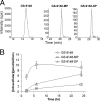Intracellular metabolism of the nucleotide prodrug GS-9131, a potent anti-human immunodeficiency virus agent
- PMID: 18056281
- PMCID: PMC2224749
- DOI: 10.1128/AAC.01209-07
Intracellular metabolism of the nucleotide prodrug GS-9131, a potent anti-human immunodeficiency virus agent
Abstract
GS-9131 is a phosphonoamidate prodrug of the novel ribose-modified phosphonate nucleotide analog GS-9148 that demonstrates potent anti-human immunodeficiency virus type 1 (HIV-1) activity and an excellent resistance profile in vitro. Prodrug moieties were optimized for the efficient delivery of GS-9148 and its active diphosphate (DP) metabolite to lymphoid cells following oral administration. To understand the intracellular pharmacology of GS-9131, incubations were performed with various types of lymphoid cells in vitro. The intracellular accumulation and antiviral activity levels of GS-9148 were limited by its lack of cellular permeation, and GS-9131 increased the delivery of GS-9148-DP by 76- to 290-fold relative to that of GS-9148. GS-9131 activation was saturable at high extracellular concentrations, potentially due to a high-affinity promoiety cleavage step. Once inside the cells, GS-9148 was efficiently phosphorylated, forming similar amounts of anabolites in primary lymphoid cells. The levels of GS-9148-DP formed in peripheral blood mononuclear cells infected with HIV-1 were similar to that in uninfected PBMCs, and approximately equivalent intracellular concentrations of GS-9148-DP and tenofovir (TVF)-DP were required to inhibit viral replication by 90%. Once it was formed, GS-9148-DP was efficiently retained in activated CD4(+) cells, with a half-life of 19 h. In addition, GS-9131 showed a low potential for drug interactions with other adenine nucleoside/nucleotide reverse transcriptase inhibitors, based on the lack of competition for anabolism between suprapharmacologic concentrations of GS-9148 and TVF and the lack of activity of GS-9131 metabolites against purine nucleoside phosphorylase, an enzyme involved in the clearance of 2',3'-dideoxyinosine. Together, these observations elucidate the cellular pharmacology of GS-9131 and illustrate its efficient loading of lymphoid cells, resulting in a prolonged intracellular exposure to the active metabolite GS-9148-DP.
Figures







Similar articles
-
Design and profiling of GS-9148, a novel nucleotide analog active against nucleoside-resistant variants of human immunodeficiency virus type 1, and its orally bioavailable phosphonoamidate prodrug, GS-9131.Antimicrob Agents Chemother. 2008 Feb;52(2):655-65. doi: 10.1128/AAC.01215-07. Epub 2007 Dec 3. Antimicrob Agents Chemother. 2008. PMID: 18056282 Free PMC article.
-
Activation of 9-[(R)-2-[[(S)-[[(S)-1-(Isopropoxycarbonyl)ethyl]amino] phenoxyphosphinyl]-methoxy]propyl]adenine (GS-7340) and other tenofovir phosphonoamidate prodrugs by human proteases.Mol Pharmacol. 2008 Jul;74(1):92-100. doi: 10.1124/mol.108.045526. Epub 2008 Apr 22. Mol Pharmacol. 2008. PMID: 18430788
-
Natural substrate concentrations can modulate the prophylactic efficacy of nucleotide HIV reverse transcriptase inhibitors.J Virol. 2011 Jul;85(13):6610-7. doi: 10.1128/JVI.00311-11. Epub 2011 Apr 27. J Virol. 2011. PMID: 21525346 Free PMC article.
-
Tenofovir alafenamide: A novel prodrug of tenofovir for the treatment of Human Immunodeficiency Virus.Antiviral Res. 2016 Jan;125:63-70. doi: 10.1016/j.antiviral.2015.11.009. Epub 2015 Nov 27. Antiviral Res. 2016. PMID: 26640223 Review.
-
Anti-HIV Nucleoside Phosphonate GS-9148 and Its Prodrug GS-9131: Scale Up of a 2'-F Modified Cyclic Nucleoside Phosphonate and Synthesis of Selected Amidate Prodrugs.Curr Protoc Nucleic Acid Chem. 2014 Mar 26;56:14.10.1-21. doi: 10.1002/0471142700.nc1410s56. Curr Protoc Nucleic Acid Chem. 2014. PMID: 25606977 Review.
Cited by
-
Nucleotide analogue prodrug tenofovir disoproxil enhances lymphoid cell loading following oral administration in monkeys.Mol Pharm. 2009 Jul-Aug;6(4):1145-51. doi: 10.1021/mp900036s. Mol Pharm. 2009. PMID: 19545170 Free PMC article.
-
A nanoluciferase SARS-CoV-2 for rapid neutralization testing and screening of anti-infective drugs for COVID-19.Nat Commun. 2020 Oct 15;11(1):5214. doi: 10.1038/s41467-020-19055-7. Nat Commun. 2020. PMID: 33060595 Free PMC article.
-
Mechanism of resistance to GS-9148 conferred by the Q151L mutation in HIV-1 reverse transcriptase.Antimicrob Agents Chemother. 2011 Jun;55(6):2662-9. doi: 10.1128/AAC.01738-10. Epub 2011 Mar 14. Antimicrob Agents Chemother. 2011. PMID: 21402840 Free PMC article.
-
Direct and indirect quantification of phosphate metabolites of nucleoside analogs in biological samples.J Pharm Biomed Anal. 2020 Jan 30;178:112902. doi: 10.1016/j.jpba.2019.112902. Epub 2019 Oct 3. J Pharm Biomed Anal. 2020. PMID: 31610397 Free PMC article. Review.
-
Clinical pharmacodynamics of obeldesivir versus remdesivir.Antimicrob Agents Chemother. 2024 Sep 4;68(9):e0096924. doi: 10.1128/aac.00969-24. Epub 2024 Aug 12. Antimicrob Agents Chemother. 2024. PMID: 39133123 Free PMC article. No abstract available.
References
-
- Beauchamp, L. M., J. V. Tuttle, M. E. Rodriguez, and M. L. Sznaidman. 1996. Guanine, pyrazolo[3,4-d]pyrimidine, and triazolo[4,5-d]pyrimidine (8-azaguanine) phosphonate acyclic derivatives as inhibitors of purine nucleoside phosphorylase. J. Med. Chem. 39:949-956. - PubMed
-
- Becher, F., R. Landman, S. Mboup, C. N. Kane, A. Canestri, F. Liegeois, M. Vray, M. H. Prevot, G. Leleu, and H. Benech. 2004. Monitoring of didanosine and stavudine intracellular trisphosphorylated anabolite concentrations in HIV-infected patients. AIDS 18:181-187. - PubMed
-
- Birkus, G., R. Wang, X. Liu, N. Kutty, H. MacArthur, T. Cihlar, C. Gibbs, S. Swaminathan, W. Lee, and M. McDermott. 2007. Cathepsin A is the major hydrolase catalyzing the intracellular hydrolysis of the antiretroviral nucleotide phosphonoamidate prodrugs GS-7340 and GS-9131. Antimicrob. Agents Chemother. 51:543-550. - PMC - PubMed
-
- Cihlar, T., A. S. Ray, C. G. Boojamra, L. Zhang, H. Hui, G. Laflamme, J. E. Vela, D. Grant, J. Chen, F. Myrick, K. L. White, Y. Gao, K.-Y. Lin, J. L. Douglas, N. T. Parkin, A. Carey, R. Pakdaman, and R. L. Mackman. 2008. Design and profiling of GS-9148, a novel nucleotide analog active against nucleoside-resistant variants of human immunodeficiency virus type 1, and its orally bioavailable phosphonoamidate prodrug, GS-9131. Antimicrob. Agents Chemother. 52:655-665. - PMC - PubMed
MeSH terms
Substances
LinkOut - more resources
Full Text Sources
Other Literature Sources
Medical
Research Materials

